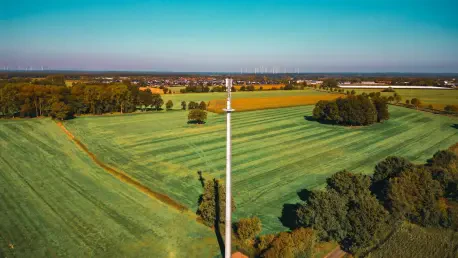In the rolling hills of rural Vermont, where internet connectivity often lags behind urban standards, ECFiber has emerged as a lifeline for approximately 10,000 customers who rely on its high-speed broadband to stay connected in an increasingly digital world. This community-driven network, part of Vermont’s communications union districts (CUDs), is now facing a pivotal moment as it transitions from its long-time operator, Great Works Internet (GWI), to a newly formed nonprofit, the Vermont ISP Operating Company (VISPO), with the handover set for January 1. A federal judge’s recent ruling has cleared the legal path for this shift, but it has also ignited intense debate over whether VISPO can maintain the stability of a service so critical to areas where alternatives like Digital Subscriber Line (DSL) offer frustratingly slow speeds. Beyond a mere change in management, this transition tests the resilience of rural broadband infrastructure, raising questions about operational readiness, financial risks, and the broader mission to bridge the digital divide in underserved regions.
Bridging the Digital Divide in Vermont
For many rural Vermonters, ECFiber represents more than just an internet provider—it’s a vital connection to the modern world, supporting everything from remote education to telehealth in communities where other options fall short. Community members, such as Holly Lague, director of libraries in Thetford, have voiced deep concerns about the potential impact of any service disruption, describing it as a “huge hurdle” given the poor performance of DSL alternatives. This reliance highlights the unique role ECFiber plays in areas often overlooked by larger commercial providers, where consistent access isn’t just a convenience but a necessity for daily life. The stakes of the upcoming transition to VISPO are immense, as any faltering could leave thousands struggling with inadequate connectivity, exacerbating the challenges of rural living in a digital age.
The mission of CUDs like ECFiber extends beyond providing service; it’s about ensuring equity in access to technology, a goal that has gained urgency as digital demands grow. These municipal entities are designed to address gaps left by profit-driven companies, building fiber networks in regions deemed unprofitable. With VISPO stepping in, the focus remains on preserving this critical infrastructure, but skepticism lingers about whether a new entity can uphold the reliability that customers have come to depend on. The transition isn’t merely operational—it’s a litmus test for whether community-led initiatives can sustain progress in closing the digital divide without sacrificing service quality during periods of change.
Navigating Legal Hurdles for a Smooth Handover
The journey to replace GWI with VISPO has been fraught with legal tension, revealing deep-seated friction between ECFiber and its outgoing operator. The conflict erupted earlier this year when GWI filed a lawsuit against ECFiber board chair F.X. Flinn, alleging espionage and attempts to poach staff, prompting ECFiber to seek a court injunction to enforce a structured transition. On August 11, Federal Judge Mary Kay Lanthier ruled in ECFiber’s favor, mandating that GWI provide access to essential infrastructure and systems while explicitly excluding obligations to train VISPO personnel or share proprietary data. This decision underscores a commitment to minimizing disruption for customers, prioritizing public interest over the intricacies of corporate disputes, though it leaves unresolved questions about the depth of support VISPO will receive during the handover.
While the court’s ruling offers a framework for moving forward, the underlying animosity between the parties casts a shadow over the process. The legal battle has exposed a breakdown in trust, with accusations of obstruction from ECFiber and counterclaims of unethical behavior from GWI. For rural customers, however, these courtroom dramas are secondary to the pressing concern of uninterrupted service. Judge Lanthier’s focus on procedural steps rather than adjudicating VISPO’s capabilities reflects a pragmatic approach, aiming to safeguard connectivity in vulnerable areas. Yet, the lingering discord suggests that cooperation between GWI and VISPO may remain strained, potentially complicating the practicalities of the transition as the January 1 deadline approaches.
Assessing Operational Challenges and Financial Implications
As VISPO prepares to take the reins, significant concerns about its operational readiness have surfaced, with critics questioning whether the nonprofit has the experience and resources to manage a network of ECFiber’s scale. GWI has openly expressed doubts, joined by external analysts like S&P Global, which issued a “negative” outlook on ECFiber’s rating, citing risks of a potential downgrade in municipal revenue bonds due to uncertainties surrounding the new operator’s capabilities. Such a downgrade could hamper future funding for network expansion, adding financial strain to an already complex situation. With VISPO’s staffing and expertise under scrutiny, the fear is that any misstep could lead to service interruptions, directly impacting rural users who have few viable alternatives to fall back on.
Despite these warnings, ECFiber and VISPO leadership remain outwardly confident, supported by the Vermont Community Broadband Board, which has signaled readiness to intervene if disruptions occur. While detailed plans for the transition remain undisclosed, this backing provides a potential safety net, suggesting that state-level oversight could mitigate some risks. Board executive director Christine Hallquist has emphasized a strong belief in continuity, though the lack of transparency about VISPO’s preparations fuels ongoing skepticism. The financial concerns, while notable, are not seen as an immediate crisis—ECFiber has weathered past challenges with unrated bonds at higher interest rates. Still, balancing operational inexperience with the need for stability remains a daunting task as the transition date nears.
Reflecting on Broader Rural Broadband Challenges
The shift to VISPO encapsulates the broader struggle of delivering reliable, affordable internet to rural areas, where market incentives often fail to drive investment. As Hallquist has pointed out, entities like ECFiber are often the only players willing to serve these communities, stepping in where commercial providers see little profit. This reality amplifies the importance of the current transition, as any failure could set back years of progress in narrowing the connectivity gap. The tension between innovation—embodied by the creation of a nonprofit operator—and the need for proven stability lies at the heart of the debate, reflecting a national challenge of ensuring rural areas aren’t left behind in the digital era.
Stakeholders across the board, from local residents to state officials, agree on the indispensable value of broadband, yet opinions split on how best to secure it during this period of change. GWI’s internal turmoil, including a recent takeover by Mac Mountain amid financial distress, adds another layer of complexity, though their continued contracts with other CUDs suggest they remain a player in Vermont’s broadband landscape. For ECFiber, the path forward hinges on VISPO proving its mettle, with community dependence making the outcome deeply personal for thousands. The transition, while a local issue, mirrors wider questions about how rural internet initiatives can evolve without sacrificing the reliability that underpins their purpose.
Looking Ahead to Sustainable Connectivity
Looking back, the saga of ECFiber’s operator switch unfolded as a microcosm of the persistent hurdles faced by rural broadband initiatives, balancing legal resolutions with practical uncertainties. The federal court’s intervention provided a structured pathway, ensuring GWI facilitated the handover without overstepping into proprietary domains. Yet, doubts about VISPO’s preparedness and the financial cautions from ratings agencies like S&P Global lingered as critical points of concern, even as community voices underscored the profound reliance on ECFiber’s network for daily needs.
Moving forward, attention must shift to actionable measures that bolster VISPO’s capacity to deliver, such as targeted state support or partnerships with experienced entities to shore up expertise. The Vermont Community Broadband Board’s commitment to step in offers a promising fallback, but proactive steps to build trust and transparency with customers will be equally vital. As rural connectivity remains a pressing priority, this transition serves as a reminder that sustainable solutions require not just innovation, but also robust safeguards to protect vulnerable communities from disruption.









